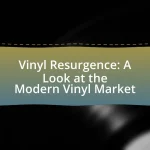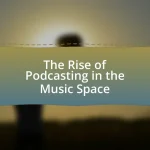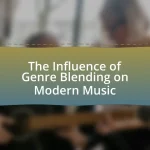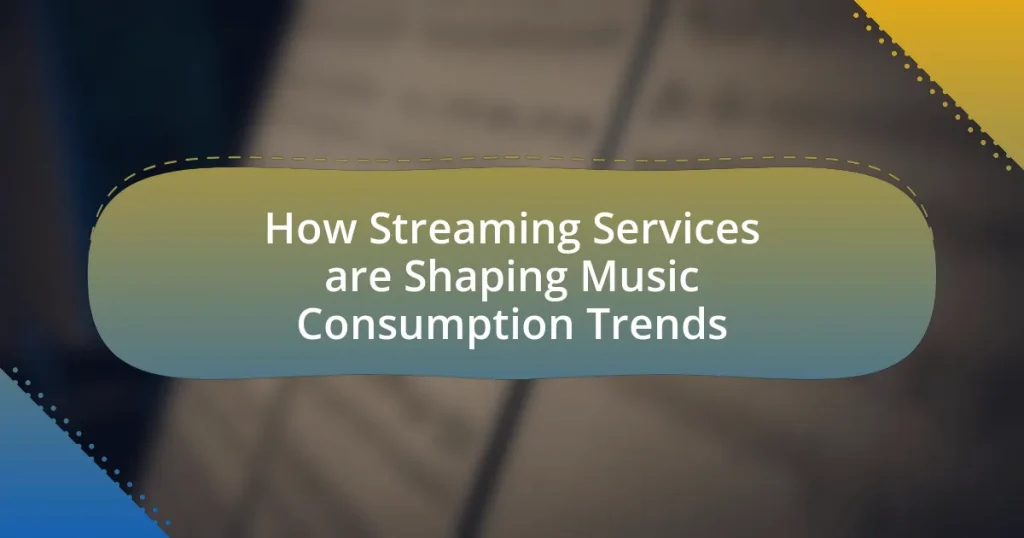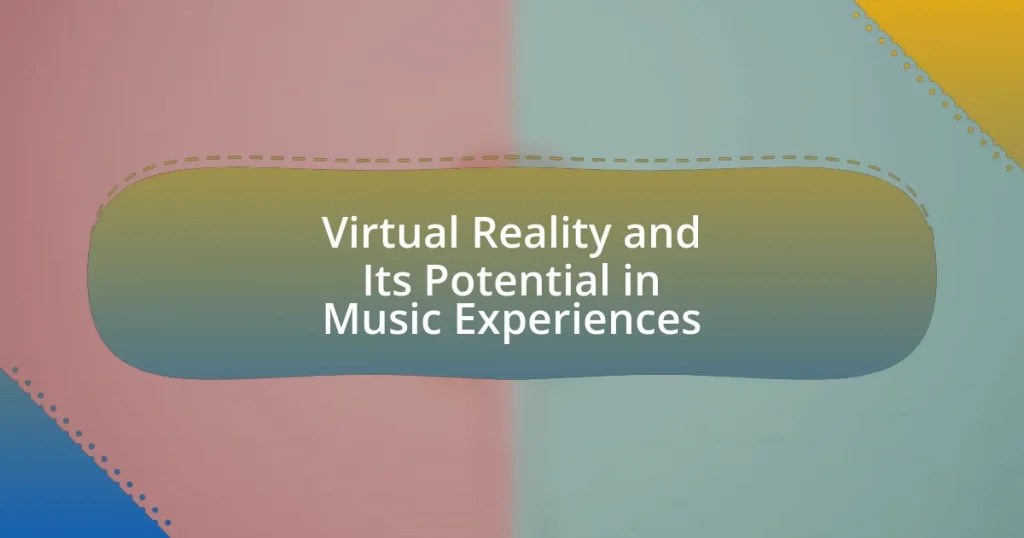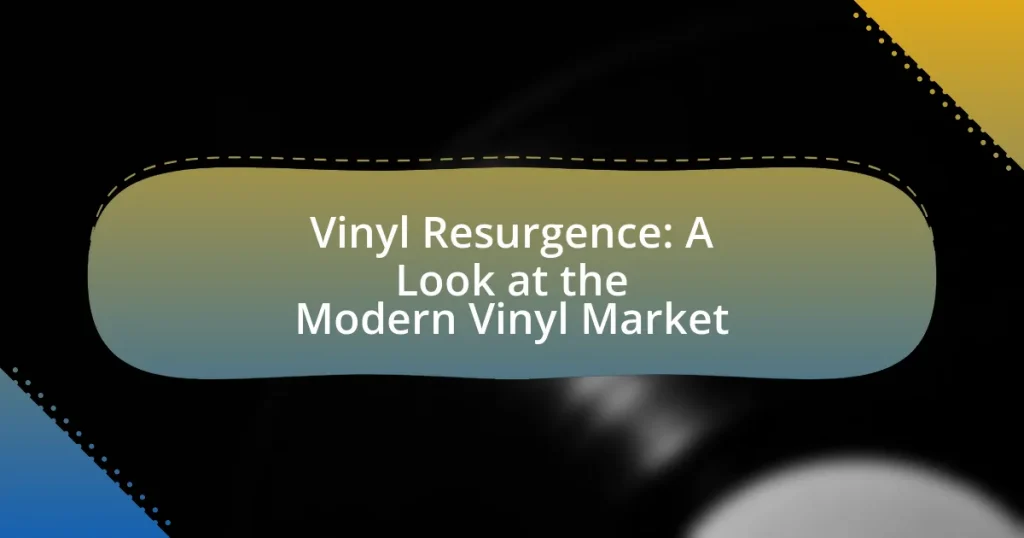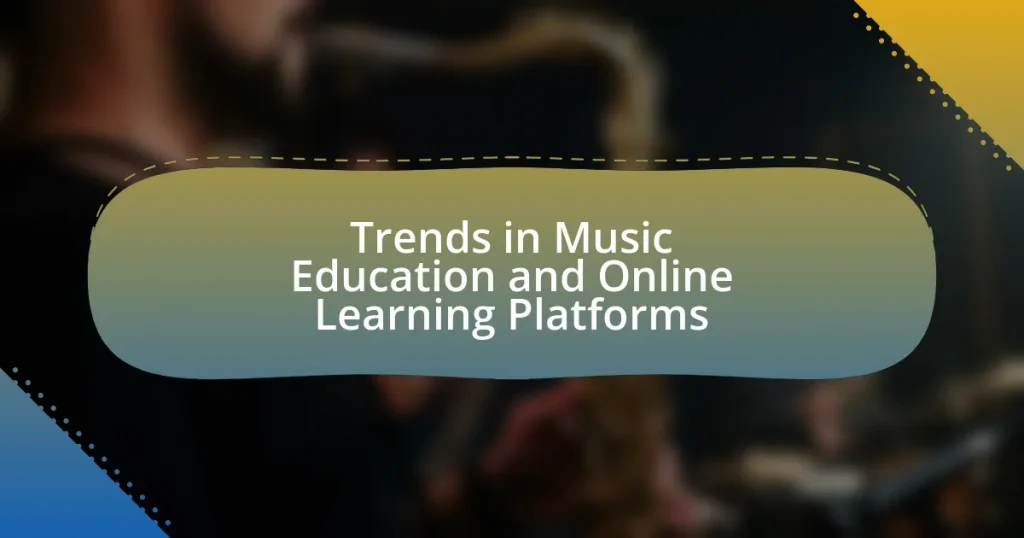Streaming services are fundamentally reshaping music consumption trends by providing instant access to extensive music libraries and personalized listening experiences. This transformation has resulted in a significant decline in physical album sales and digital downloads, with streaming accounting for over 80% of the U.S. music industry’s revenue in 2021. Key features such as personalized recommendations, user-friendly interfaces, and social sharing capabilities enhance user engagement and influence listening habits. Additionally, the impact of algorithms and curated playlists on music discovery, along with the challenges of artist compensation and market saturation, are critical aspects of this evolving landscape. The article explores these dynamics, highlighting the implications for both consumers and artists in the digital music era.
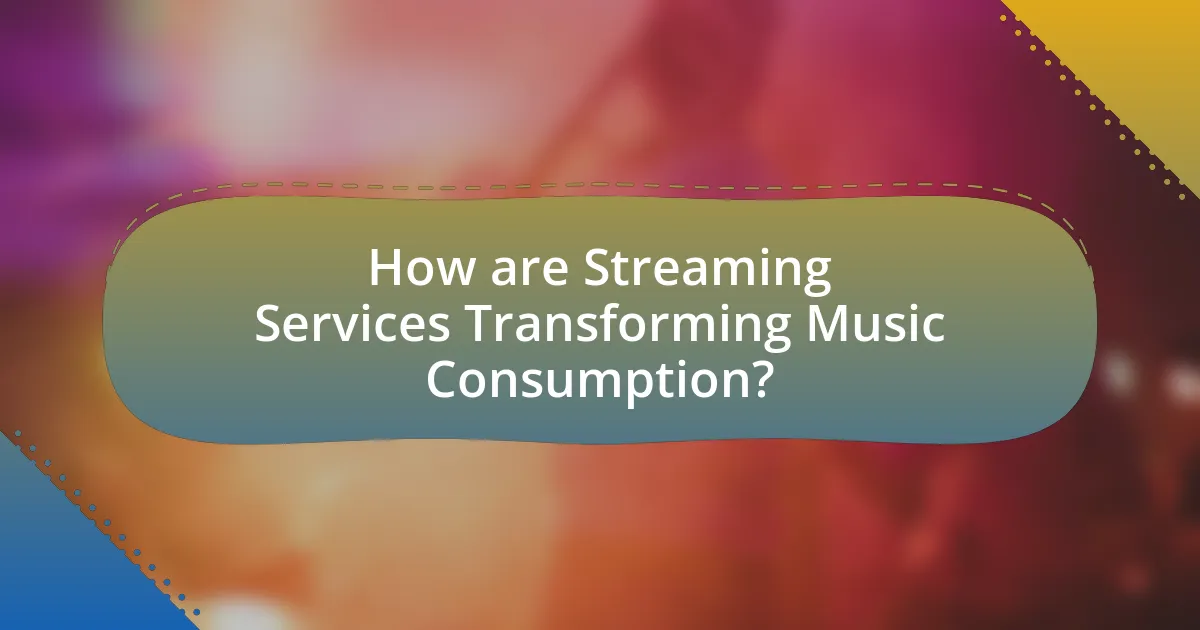
How are Streaming Services Transforming Music Consumption?
Streaming services are transforming music consumption by providing instant access to vast libraries of music, enabling users to listen on-demand. This shift has led to a decline in physical album sales and digital downloads, with streaming accounting for over 80% of the U.S. music industry’s revenue in 2021, according to the Recording Industry Association of America (RIAA). Additionally, streaming platforms utilize algorithms to personalize user experiences, influencing listening habits and promoting new artists through curated playlists. This model has democratized music access, allowing independent artists to reach global audiences without traditional gatekeepers.
What are the key features of streaming services that influence music consumption?
Key features of streaming services that influence music consumption include personalized recommendations, extensive music libraries, user-friendly interfaces, and social sharing capabilities. Personalized recommendations utilize algorithms to analyze user behavior and suggest songs, which increases engagement; for instance, Spotify’s Discover Weekly playlist has significantly boosted user listening time. Extensive music libraries provide access to millions of tracks, allowing users to explore diverse genres and artists, which enhances discovery and consumption patterns. User-friendly interfaces facilitate easy navigation and playlist creation, making it simpler for users to curate their listening experience. Lastly, social sharing capabilities enable users to share music with friends, fostering community engagement and influencing listening habits. These features collectively shape how consumers interact with and consume music in the digital age.
How do algorithms and playlists shape user listening habits?
Algorithms and playlists significantly shape user listening habits by personalizing music recommendations based on individual preferences and behaviors. Streaming services like Spotify and Apple Music utilize complex algorithms that analyze user data, such as listening history and song ratings, to curate playlists that align with users’ tastes. For instance, Spotify’s Discover Weekly playlist uses machine learning to suggest tracks that users are likely to enjoy, resulting in increased engagement and discovery of new music. Research indicates that personalized recommendations can lead to a 30% increase in user satisfaction and retention, demonstrating the effectiveness of algorithms in influencing listening patterns.
What role does accessibility play in music consumption trends?
Accessibility significantly influences music consumption trends by enabling broader audience reach and facilitating diverse listening experiences. Streaming services like Spotify and Apple Music provide instant access to vast music libraries, allowing users to discover and consume music easily across various devices. According to a 2021 report by the International Federation of the Phonographic Industry (IFPI), 62% of global music consumers use streaming services, highlighting how accessibility drives engagement and shifts listening habits. This ease of access not only increases the volume of music consumed but also promotes the exploration of different genres and artists, ultimately reshaping the music landscape.
Why are streaming services preferred over traditional music formats?
Streaming services are preferred over traditional music formats primarily due to their convenience and accessibility. Users can instantly access vast libraries of music from anywhere with an internet connection, eliminating the need for physical media. According to a 2021 report by the Recording Industry Association of America, streaming accounted for 83% of the U.S. music industry’s revenue, highlighting its dominance over traditional formats like CDs and vinyl. Additionally, streaming services offer personalized playlists and recommendations, enhancing user experience and engagement, which traditional formats cannot provide.
What advantages do streaming services offer to consumers?
Streaming services offer consumers convenience, affordability, and a vast selection of content. Consumers can access a wide range of music anytime and anywhere through internet-enabled devices, eliminating the need for physical media. Additionally, many streaming platforms provide subscription models that are often cheaper than purchasing individual albums or songs, making music more accessible. According to a report by the Recording Industry Association of America, streaming accounted for 83% of the U.S. music industry’s revenue in 2020, highlighting its dominance and appeal among consumers.
How do cost structures of streaming services compare to physical music purchases?
The cost structures of streaming services are generally lower and more flexible compared to physical music purchases. Streaming services operate on a subscription model, where users pay a monthly fee for access to a vast library of music, often costing around $10 to $15 per month. In contrast, physical music purchases, such as CDs or vinyl records, typically range from $10 to $30 per album, requiring upfront payment for each individual item.
Additionally, streaming services incur lower distribution and production costs since they do not require physical inventory or shipping, while physical music purchases involve manufacturing, packaging, and logistics expenses. According to the Recording Industry Association of America (RIAA), revenue from streaming surpassed that from physical sales in 2015, highlighting the shift in consumer preference towards the more cost-effective streaming model.
What impact do streaming services have on music artists and the industry?
Streaming services significantly impact music artists and the industry by altering revenue models and consumption patterns. These platforms, such as Spotify and Apple Music, have shifted the focus from album sales to streaming, resulting in lower per-stream payouts for artists. For instance, in 2021, Spotify reported an average payout of approximately $0.003 to $0.005 per stream, which has led many artists to rely on touring and merchandise sales for income. Additionally, streaming services have democratized music distribution, allowing independent artists to reach global audiences without traditional label support. This shift has transformed marketing strategies, with artists increasingly using social media and playlists to promote their work. Overall, while streaming services provide broader access to music, they also challenge artists to adapt to a new economic landscape.
How do streaming platforms affect artist revenue and exposure?
Streaming platforms significantly impact artist revenue and exposure by altering how music is consumed and monetized. These platforms typically operate on a subscription or ad-supported model, which generates revenue primarily through user subscriptions and advertising. However, artists receive a fraction of this revenue, often calculated per stream, leading to lower overall earnings compared to traditional sales methods. For instance, a report from the Music Industry Revenue in 2021 indicated that artists earn approximately $0.003 to $0.005 per stream on platforms like Spotify, which translates to needing millions of streams to generate substantial income.
In terms of exposure, streaming platforms provide artists with a global audience, allowing them to reach listeners who may not have discovered their music otherwise. Playlists curated by these platforms can significantly boost an artist’s visibility, as being featured on popular playlists can lead to millions of additional streams. According to a study by the International Federation of the Phonographic Industry (IFPI) in 2022, 70% of users discover new music through streaming services, highlighting their role in artist exposure. Thus, while streaming platforms can enhance an artist’s reach, the financial compensation structure often remains a challenge for sustainable revenue generation.
What changes have occurred in music production and distribution due to streaming?
Streaming has fundamentally transformed music production and distribution by enabling artists to release music more frequently and reach global audiences instantly. This shift has led to a decline in traditional album releases, with many artists opting for singles or EPs to maintain listener engagement. According to a report by the International Federation of the Phonographic Industry (IFPI), streaming accounted for 62.1% of global recorded music revenue in 2020, highlighting its dominance over physical sales and downloads. Additionally, streaming platforms provide artists with direct access to analytics, allowing them to tailor their marketing strategies based on listener data. This data-driven approach enhances promotional efforts and optimizes audience targeting, further changing the landscape of music distribution.
How do streaming services influence music discovery and trends?
Streaming services significantly influence music discovery and trends by utilizing algorithms that personalize user experiences and promote new artists. These platforms analyze user listening habits, preferences, and behaviors to curate playlists and recommendations, making it easier for listeners to discover diverse genres and emerging talent. For instance, Spotify’s Discover Weekly playlist has been credited with boosting the visibility of lesser-known artists, leading to increased streams and fan engagement. According to a 2021 report by the International Federation of the Phonographic Industry, 70% of users discover new music through streaming services, highlighting their pivotal role in shaping contemporary music trends.
What are the implications of streaming services on music genres and diversity?
Streaming services significantly impact music genres and diversity by facilitating access to a broader range of music, which encourages genre blending and the emergence of new styles. These platforms, such as Spotify and Apple Music, utilize algorithms that promote diverse playlists, exposing listeners to various genres beyond their usual preferences. For instance, a report by the International Federation of the Phonographic Industry (IFPI) in 2021 indicated that 70% of users discover new music through streaming services, highlighting their role in diversifying music consumption. Additionally, the global reach of these platforms allows artists from underrepresented genres to gain visibility, fostering a more inclusive music landscape.
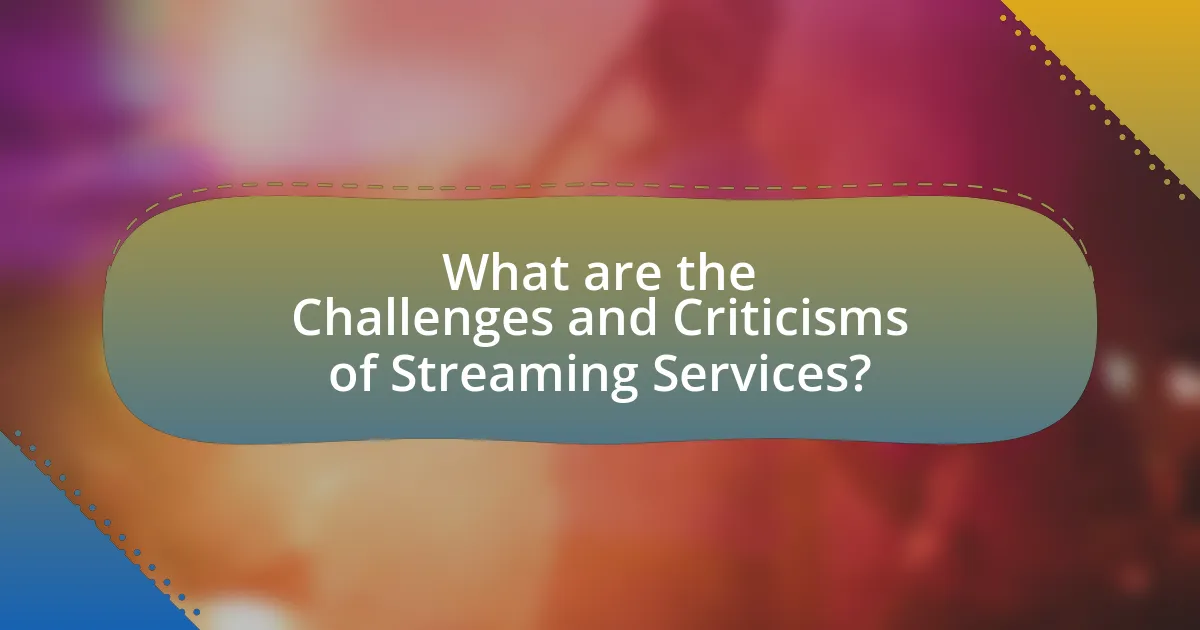
What are the Challenges and Criticisms of Streaming Services?
Streaming services face several challenges and criticisms, including issues related to artist compensation, market saturation, and content quality. Artist compensation is a significant concern, as many musicians receive a fraction of a cent per stream, leading to financial instability for independent artists. According to a 2021 report by the Music Industry Research Association, only about 12% of musicians earn a living wage from streaming platforms. Market saturation presents another challenge, with numerous services competing for consumer attention, which can dilute brand loyalty and make it difficult for new entrants to gain traction. Additionally, criticisms regarding content quality arise as algorithms often prioritize popular tracks over diverse or niche music, potentially stifling artistic innovation. These challenges highlight the complexities of the streaming landscape and its impact on music consumption trends.
What concerns are raised regarding artist compensation on streaming platforms?
Concerns regarding artist compensation on streaming platforms primarily focus on the low per-stream payout rates that artists receive. For instance, reports indicate that artists earn an average of $0.003 to $0.005 per stream, which is significantly lower than traditional sales models. This compensation structure raises issues about the sustainability of artists’ livelihoods, as many rely on live performances and merchandise sales to supplement their income. Additionally, the disparity in earnings often favors major record labels and established artists over independent musicians, further exacerbating inequalities within the music industry.
How do streaming royalties compare to traditional music sales?
Streaming royalties are significantly lower than traditional music sales. For instance, artists typically earn between $0.003 to $0.005 per stream on platforms like Spotify, whereas a single digital download can generate around $0.70 to $1.00 for the artist. This stark difference highlights the financial challenges artists face in the streaming era, as they need millions of streams to match the income from a few hundred downloads. According to a 2021 report by the Recording Industry Association of America, streaming accounted for 83% of the music industry’s revenue, yet the per-stream payout remains a contentious issue for artists seeking fair compensation.
What are the arguments against the sustainability of streaming models?
Arguments against the sustainability of streaming models include their reliance on low per-stream payouts, which can undermine artist revenue. For instance, a report by the Music Industry Research Association indicates that artists earn an average of $0.003 to $0.005 per stream, making it difficult for many to sustain a living solely from streaming income. Additionally, the environmental impact of data centers supporting streaming services raises concerns, as they contribute significantly to carbon emissions. According to a study by the Shift Project, digital technologies, including streaming, account for about 4% of global greenhouse gas emissions. These factors highlight the economic and environmental challenges that question the long-term viability of streaming models in the music industry.
How do streaming services affect music quality and consumer experience?
Streaming services significantly impact music quality and consumer experience by offering convenience and accessibility while often compromising audio fidelity. Many streaming platforms use compressed audio formats, such as MP3 or AAC, which reduce file size but can diminish sound quality compared to lossless formats like FLAC. For instance, Spotify streams at a maximum of 320 kbps, which, while sufficient for casual listening, may not satisfy audiophiles who prefer higher fidelity. Additionally, the user experience is enhanced through personalized playlists, algorithm-driven recommendations, and the ability to access vast libraries of music instantly, leading to increased engagement and discovery. According to a 2021 report by the International Federation of the Phonographic Industry, streaming accounted for 62% of global recorded music revenue, highlighting its dominance in shaping consumer habits and preferences.
What are the differences in audio quality between streaming and physical formats?
Streaming formats typically offer lower audio quality compared to physical formats. This difference arises because streaming services often compress audio files to reduce data usage and improve loading times, resulting in a loss of detail and fidelity. For instance, standard streaming quality may use lossy compression formats like MP3 or AAC, which can reduce audio quality to around 128-320 kbps, while physical formats like CDs provide uncompressed audio at 1,411 kbps. Additionally, high-resolution audio formats available on physical media, such as vinyl or high-definition digital files, can deliver superior sound quality, capturing a broader frequency range and dynamic range than most streaming options.
How do user interfaces and experience impact music consumption?
User interfaces and user experience significantly impact music consumption by influencing user engagement and satisfaction. A well-designed interface facilitates easy navigation, allowing users to discover and access music quickly, which can lead to increased listening time. For instance, platforms like Spotify and Apple Music utilize algorithms to personalize recommendations, enhancing user experience and encouraging more frequent use. Research indicates that 70% of users prefer platforms with intuitive interfaces, as they reduce frustration and improve overall enjoyment, ultimately driving higher consumption rates.
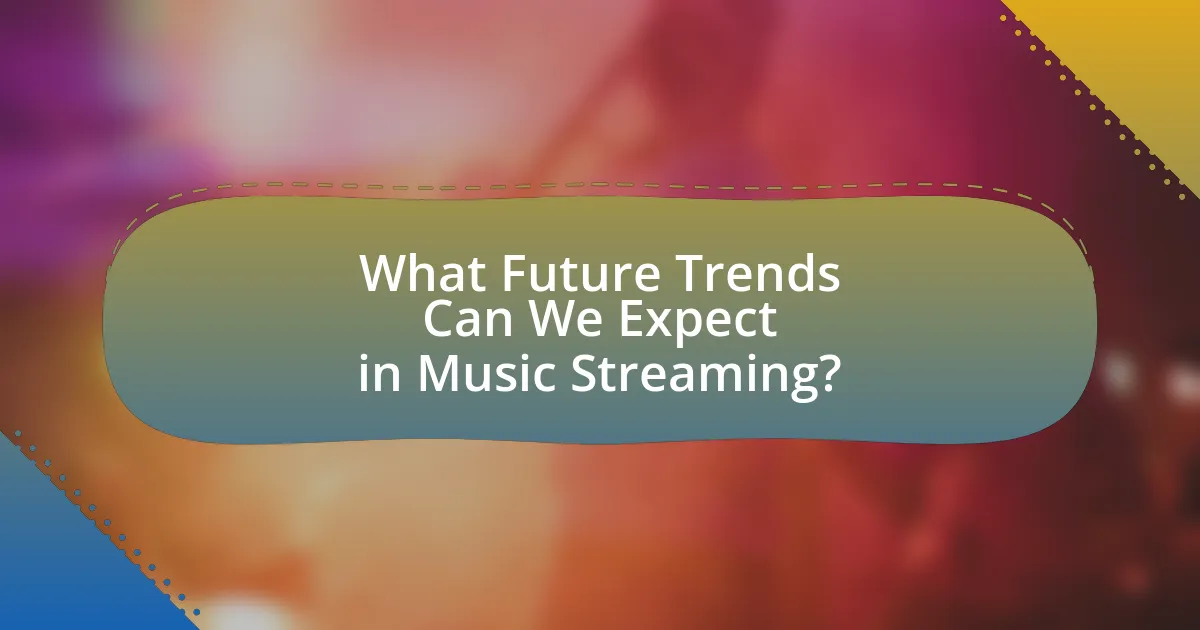
What Future Trends Can We Expect in Music Streaming?
Future trends in music streaming include increased personalization through AI algorithms, the rise of immersive audio experiences, and the integration of social features. Streaming services are leveraging advanced machine learning to analyze user behavior, enabling them to curate highly personalized playlists and recommendations, which enhances user engagement. Additionally, platforms are investing in spatial audio technology, providing listeners with a more immersive experience that mimics live performances. Social features, such as collaborative playlists and integrated sharing options, are becoming more prevalent, fostering community interaction among users. According to a report by Deloitte, 2023 is expected to see a 20% increase in the adoption of personalized music experiences, indicating a significant shift in how consumers engage with music streaming services.
How are technological advancements shaping the future of music streaming?
Technological advancements are significantly shaping the future of music streaming by enhancing user experience, improving accessibility, and enabling personalized content delivery. Innovations such as artificial intelligence and machine learning allow streaming platforms to analyze user behavior and preferences, leading to tailored playlists and recommendations. For instance, Spotify’s algorithm curates personalized playlists like Discover Weekly, which has contributed to a 40% increase in user engagement. Additionally, advancements in cloud computing facilitate seamless streaming across devices, ensuring that users can access their music anytime, anywhere. The integration of high-resolution audio formats, such as FLAC and MQA, is also elevating sound quality, appealing to audiophiles and expanding market reach. These technological developments are not only transforming how music is consumed but also influencing industry dynamics, including artist distribution and revenue models.
What role will artificial intelligence play in music recommendations?
Artificial intelligence will play a crucial role in music recommendations by analyzing user data to personalize listening experiences. AI algorithms process vast amounts of information, including listening history, user preferences, and contextual factors, to suggest songs and artists that align with individual tastes. For instance, platforms like Spotify utilize machine learning models to enhance their recommendation systems, resulting in a 30% increase in user engagement according to a study by the International Journal of Information Management. This data-driven approach allows streaming services to adapt to changing user behaviors and preferences, ultimately shaping music consumption trends.
How might virtual reality and augmented reality influence music experiences?
Virtual reality (VR) and augmented reality (AR) significantly enhance music experiences by creating immersive environments that engage listeners in novel ways. VR allows users to attend virtual concerts from anywhere in the world, providing a sense of presence and interaction that traditional streaming cannot offer. For instance, platforms like Oculus Venues host live performances where users can feel as if they are physically present in the venue, enhancing emotional connection to the music. AR, on the other hand, overlays digital elements onto the real world, enabling interactive experiences such as visualizations that respond to music in real-time, as seen in apps like Magic Leap. These technologies not only transform how audiences consume music but also expand the creative possibilities for artists, allowing them to design unique performances that blend audio and visual art.
What strategies can consumers adopt to enhance their music streaming experience?
Consumers can enhance their music streaming experience by utilizing personalized playlists and exploring curated content. Personalized playlists, such as those generated by algorithms based on listening habits, allow users to discover new music that aligns with their tastes, increasing engagement and satisfaction. Additionally, exploring curated content from platforms like Spotify or Apple Music can introduce listeners to new genres and artists, broadening their musical horizons. According to a 2021 report by the International Federation of the Phonographic Industry, 70% of users reported that personalized recommendations significantly improved their streaming experience, highlighting the effectiveness of these strategies.
How can users effectively curate their playlists for better enjoyment?
Users can effectively curate their playlists for better enjoyment by selecting songs that create a cohesive mood or theme. This involves considering the emotional tone of each track and how it contributes to the overall listening experience. Research indicates that playlists with a consistent vibe enhance user satisfaction, as listeners often seek music that resonates with their current feelings or activities. For example, a study published in the Journal of Consumer Research found that playlists tailored to specific contexts, such as workouts or relaxation, significantly improve listener engagement and enjoyment. By focusing on mood alignment and thematic consistency, users can create playlists that are more enjoyable and fulfilling.
What are the best practices for discovering new music on streaming platforms?
To discover new music on streaming platforms effectively, users should utilize curated playlists, explore algorithm-driven recommendations, and engage with social features. Curated playlists, often created by music experts or the platform itself, provide a diverse selection of new tracks tailored to various moods and genres. For instance, Spotify’s “Discover Weekly” playlist uses algorithms to analyze listening habits and suggest new songs, which has been shown to increase user engagement and satisfaction. Additionally, users can follow artists and friends to receive updates on new releases and recommendations, enhancing the discovery experience through social interaction. Engaging with these features allows listeners to uncover a broader range of music that aligns with their tastes.

